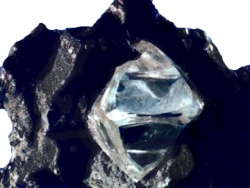
December Editorial
Carbon exoplanets

December Editorial
Carbon exoplanets
|
|
Exoplanets (also known as 'extrasolar planets') are planets outside the Solar System. Until recently such planets existed only in theory. Scientific advances in recent have now emphatically confirmed that these planets are real. As of January this year astronomers have confirmed the detection of 518 such planets, and there are many more candidates still awaiting confirmation. Although the existence of exoplanets is interesting, for geology enthusiasts the real questions are what minerals these planets are made of and how geologically comparable they are to Earth.
By combining new and existing measurements, Madhusudhan has discovered that WASP-12b is rich in pure carbon. The carbon-to-oxygen ratio of the planetís atmosphere is greater than 1 (in comparison the Solar C/0 is 0.54). If oxygen is abundant in a planetary atmosphere it will interact with carbon to create silicate-based rocks, for example quartz. But with little oxygen available, a planetís core is likely to be composed of pure carbon - meaning the core may be diamond, graphite or liquid carbon. And the atmosphere of the planet will be rich in methane and carbon monoxide. Although WASP-12b is the first planet of its kind to to be discovered, carbon-enriched solid planets are a real possibility. If these do exist, it is likely that they will have mountains built of diamonds, but sand will be extremely rare. None of the planets in our solar system is known to have more carbon than oxygen, or a ratio of one or greater. But it is also true that we donít know what the ratio is for some of our planets, for example, Jupiter. So another interesting question is whether Jupiter, the only possible analogue for WASP-12b in our Solar system, bears many similarities to the WASP-12b. Unfortunately at present it is impossible to answer this question because we canít measure the carbon-to-oxygen ratio for Jupiter using the same methods as Madhusudhan did, i.e. spectroscopy. This works on WASP-12b because it is a hot planet very close to its star, but Jupiter is a cold planet. Most oxygen is believed to be trapped in water which, due to the planetís temperature, has condensed out of the atmosphere and is not revealed by spectroscopy. NASAís Juno mission will be launched in 2011 and is set to arrive at Jupiter in 2016. As one of its tasks, this probe will measure how abundant oxygen is on Jupiter. This should provide us with an answer as to whether Jupiter, like WASP-12b, is carbon-rich. Reference:Nikku Madhusudhan, Joseph Harrington, Kevin B. Stevenson, Sarah Nymeyer, Christopher J. Campo, Peter J. Wheatley, Drake Deming, Jasmina Blecic, Ryan A. Hardy, Nate B. Lust, David R. Anderson, Andrew Collier-Cameron, Christopher B. T. Britt, William C. Bowman, Leslie Hebb, Coel Hellier, Pierre F. L. Maxted, Don Pollacco & Richard G. West. A high C/O ratio and weak thermal inversion in the atmosphere of exoplanet WASP-12b. Nature, 2011, 469, pp. 64Ė67.
© Biscuit Software 2004-2015 | ||||||||||||